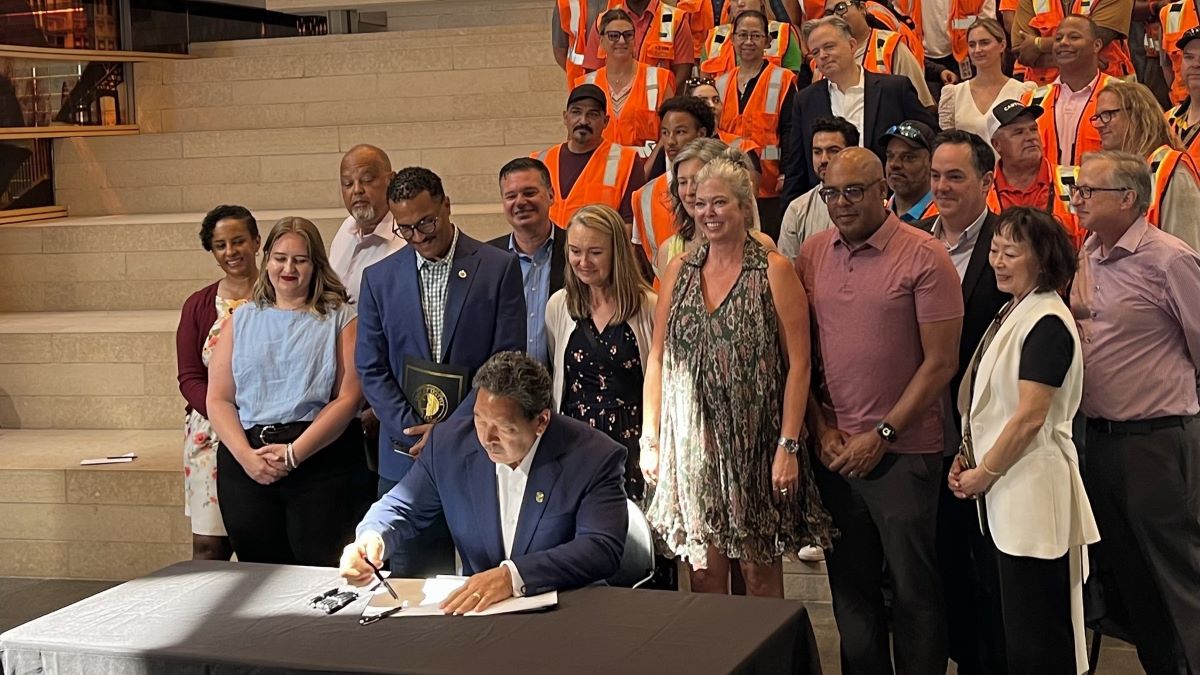
Mayor Harrell signs legislation for the Seattle Transportation Levy. Photo by Linda Lam courtesy of SDOT.
A collaborative effort
We could not have made it to this point without leadership, collaboration and hard work from many, many stakeholders: Mayor Bruce Harrell and staff; Transportation Chair Rob Saka, the Seattle City Council, and the council staff; Greg Spotts and the dedicated staff at the Seattle Department of Transportation; and our tireless advocacy partners including Disability Rights Washington, Seattle Neighborhood Greenways, and Cascade Bicycle Club, among others!The process began in earnest when Mayor Bruce Harrell put forward a $1.45 billion proposal in May. Once transmitted to Council, Transportation Chair Rob Saka increased the package by $100 million, and led a series of public forums where Councilmembers grappled with issues such as district earmarks vs. a citywide approach. This was the first levy created under the new district council system.
Many advocacy groups pushed hard to make this an even bigger investment. Councilmember Morales was a champion of this effort, pushing the baseline with a bold amendment to increase the size of the levy to $1.7 billion. Though that amendment did not pass, she did pass another important amendment: Restoring funding for the Neighborhood-Initiated Safety Partnership Program. We are grateful to Councilmember Morales and everyone who spoke up for this equity-oriented program, a top priority for the Seattle DOT’s Transportation Equity Workgroup.
Though there was disagreement over the size of the package, this will ultimately be the largest levy ever put to Seattle voters, and a transformational investment in city infrastructure.
What will this levy do?
At a high level, this levy will invest in the nuts and bolts of our transportation system, with an emphasis on safety.The package prioritizes a safer and more connected Seattle for everyone. It includes:
- $70 million for Vision Zero to eliminate traffic fatalities and serious injuries and ensure more people can get around safely. Additional safety investments include funding for Safe Routes to Schools and targeted improvements for dangerous streets like Aurora Ave N.
- A historic investment of $193 million in pedestrian safety, a 78% increase compared to the initial proposal in April. Under this, the levy commits $111 million to build at least 350 new sidewalk blocks, prioritizing schools, transit stops, and specific geographies (in Districts 1, 2, and 5). The plan also includes funding for sidewalk repairs, accessible ADA curb ramps, and safer crossings.
- $151 million to make transit corridors more reliable, with improved connections to Link Light Rail and bus stops. In this, $9 million specifically targets rider safety and security.
- People biking will benefit from about a 20% increased investment over the initial proposal to expand protected bike lanes, connect schools to bike paths, and maintain and improve existing infrastructure, fostering more active transportation.
- For the first time, the levy creates a People Streets and Public Spaces initiative to redesign streets for vibrant public spaces with community collaboration, with plans for downtown activation and a $10M investment for pedestrian lighting near transit stops for added safety.
- Finally, there is funding for basic road maintenance and bridge updates, which will benefit all modes by making our roads smoother and extending the life of our bridges.
This levy also includes policies that will boost “good governance,” a high priority for this council as a whole, but especially Transportation Chair Saka. One example is increasing the number of representatives with technical expertise, such as auditing, on the Levy Oversight Committee members, as well as members representing census tracts identified as high “equity priority” by the City.
Finally, we all know this levy isn’t going to do everything – and that the funding is nowhere near sufficient to meet all of our transportation needs. To help address this, the levy creates a directive to develop a funding strategy for the sidewalk network and bridges.
What happens next
With the package fully developed, we move into “campaign mode” to build public support for these generational investments. TCC is working with partners to set up a campaign committee, which will officially kick off later this summer.It’s a very full ballot this year — with presidential, gubernatorial, state legislative, and local candidates; plus multiple statewide ballot initiatives. It will be critical that we come together and ensure this levy has the support it needs to pass. Keep an eye out for more ways to get involved in our newsletter!




